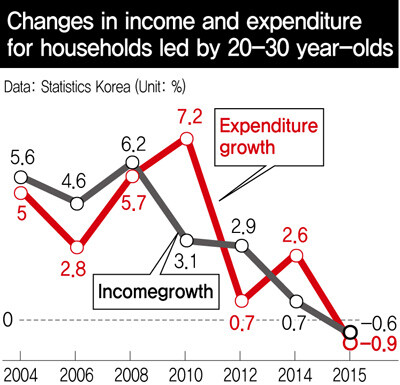hankyoreh
Links to other country sites 다른 나라 사이트 링크
For twenty and thirtysomethings, the first year of declining income

Families with breadwinners in their twenties and thirties experienced minus growth in income and expenditures for the first time last year.
The reason for the situation includes both difficulties finding work and the irregular or otherwise unstable jobs younger South Koreans do manage to find.
A report on household trends by Statistics Korea on Mar. 8 showed an average 2015 monthly income (including all earned income, business income, and interest) of 4,316,000 won (US$3,560) for households with two or more members and a chief earner aged 39 or younger. The figure was down 0.6% from the year before.
The decline in income for twenty- and thirtysomething household heads was the first since the survey began in 2003. While income growth for the population segment varied significantly over the years - with levels of 5.6% in 2004, 6.2% in 2008, 2.9% in 2012, and 7.4% in 2013 - it remained consistently positive. In 2014, it fell to 0.7%; the following year, it dropped to negative numbers.
The 20-to-39 age group was the only one to experience declining income. Average monthly income for households headed by people aged 40 to 49 rose 2.8% to 4,959,000 won (US$4,090) last year, while the level for households headed by those aged 50 to 59 increased by 2.0% to 5,055,000 won (US$4,170). The biggest jump was among households headed by people aged 60 or older, which rose 6.8% to 3,004,000 won (US$2,480).
The biggest factor in declining income for households in the 20-to-39 age group was unstable employment. While employment increased last year by 337,000 positions, most went to people in their fifties or older. While the number of employed persons aged 50-59 and 60 and over rose by 149,000 and 172,000, respectively, the increase for younger people aged 15 to 29 was just 68,000. Among people aged 30 to 39, employment decreased by 38,000 positions. Youth unemployment stood at 9.2% for 2015, its highest level ever.
Also contributing to the income level decline is deteriorating job quality, with most new employment found in irregular positions or “livelihood-type start-ups.” Of the four million young South Koreans graduating school or dropping out to find their first jobs last year, 812,000 of them, or 20.3%, started out with contract positions of one year or less. The rate of newly hired younger people holding irregular positions rose from 54% in 2008 to 64% last August.
With income falling, many twenty- and thirtysomethings are tightening their belts. Average monthly expenditures for households headed by someone 39 or younger totaled 3,359,000 won (US$3,260) last year, down 0.9% from 2014. The decline in household expenditures in the 20-to-39 age group was also a first since 2003. The percentage spent on housing (rent) spiked to 26.6%, while outlays fell for clothing and shoes (-9.3%) and household services and products such as furniture and appliances (-10.7%).
The growing likelihood of a vicious cycle of youth unemployment leading to falling income and a decline in spending has prompted the South Korean government to make youth employment a policy priority.
“We’ve announced several policies in the past for jobs for young people, but many of them were lacking in effectiveness,” said the Ministry of Strategy and Finance.
“We plan to announce measures within the month to extend real help to younger people,” the ministry said.
By Kim So-youn, staff reporter
Please direct questions or comments to [english@hani.co.kr]

Editorial・opinion
![[Column] Has Korea, too, crossed the Rubicon on China? [Column] Has Korea, too, crossed the Rubicon on China?](https://flexible.img.hani.co.kr/flexible/normal/500/300/imgdb/original/2024/0419/9317135153409185.jpg) [Column] Has Korea, too, crossed the Rubicon on China?
[Column] Has Korea, too, crossed the Rubicon on China?![[Correspondent’s column] In Japan’s alliance with US, echoes of its past alliances with UK [Correspondent’s column] In Japan’s alliance with US, echoes of its past alliances with UK](https://flexible.img.hani.co.kr/flexible/normal/500/300/imgdb/original/2024/0419/2317135166563519.jpg) [Correspondent’s column] In Japan’s alliance with US, echoes of its past alliances with UK
[Correspondent’s column] In Japan’s alliance with US, echoes of its past alliances with UK- [Editorial] Does Yoon think the Korean public is wrong?
- [Editorial] As it bolsters its alliance with US, Japan must be accountable for past
- [Guest essay] Amending the Constitution is Yoon’s key to leaving office in public’s good graces
- [Editorial] 10 years on, lessons of Sewol tragedy must never be forgotten
- [Column] A death blow to Korea’s prosecutor politics
- [Correspondent’s column] The US and the end of Japanese pacifism
- [Guest essay] How Korea turned its trainee doctors into monsters
- [Guest essay] As someone who helped forge Seoul-Moscow ties, their status today troubles me
Most viewed articles
- 1[Column] The clock is ticking for Korea’s first lady
- 2Hong Se-hwa, voice for tolerance whose memoir of exile touched a chord, dies at 76
- 3After 2 months of delayed, denied medical care, Koreans worry worst may be yet to come
- 4[Column] Has Korea, too, crossed the Rubicon on China?
- 5US overtakes China as Korea’s top export market, prompting trade sanction jitters
- 6[Correspondent’s column] In Japan’s alliance with US, echoes of its past alliances with UK
- 7All eyes on Xiaomi after it pulls off EV that Apple couldn’t
- 8Samsung barricades office as unionized workers strike for better conditions
- 9[Photo] Smile ambassador, you’re on camera
- 10[Correspondent’s column] The US and the end of Japanese pacifism